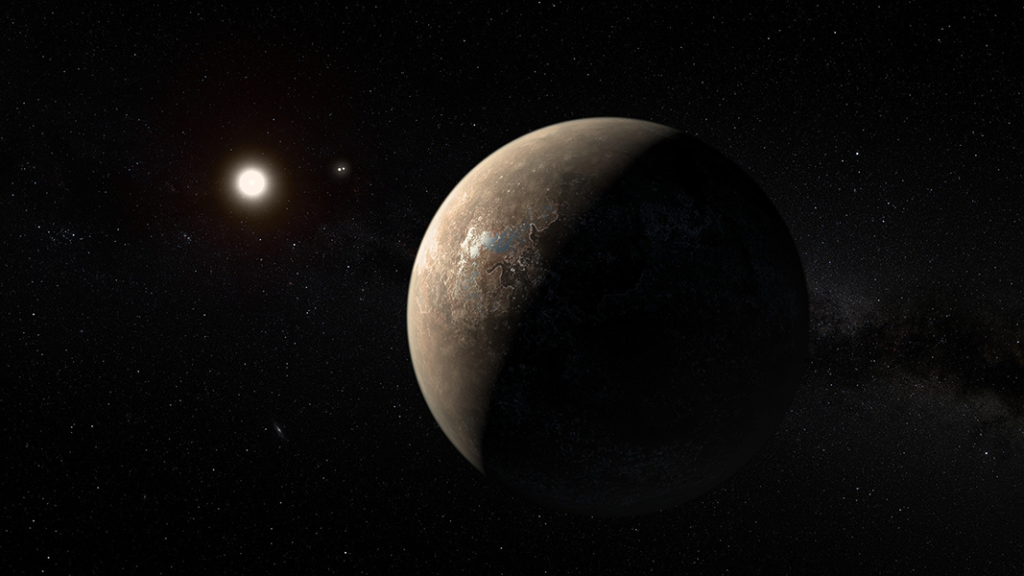Thanks to NASA’s Kepler Mission, over one-thousand potentially habitable exoplanets have been discovered to-date, orbiting around their respective stars. An exoplanet refers to any planet outside of our solar system. The discoveries of these worlds are a major accomplishment for us, but the question still persists: which of these exoplanets may best host carbon-based life similar to what the Earth hosts? It would be impractical, given our current abilities, for us to send life to the planet and see whether it lives or dies. Instead, we can safely attempt to determine this by simulating the planet’s environment and testing it with what we know about life here.
The type of star(s) in a solar system plays an important role in a planet’s environment. About 70% of the stars in the Milky Way Galaxy are classified as M dwarfs, which are low-mass stars that often produce solar flares. These flares are accompanied by bursts of high-energy protons that fly away from the star, also known as stellar proton events.
Many of the exoplanets that scientists have hypothesized may support life orbit closely around M dwarfs. When in close proximity, stellar proton events can increase the level of radiation on the surface of the exoplanet. To determine if these types of exoplanets can then sustain life as we know it, we must ensure that the levels of surface radiation do not surpass known biological tolerances for radiation. For instance, given an approximate level of surface radiation, how possible would it be for humans, plants, extremophiles, and other Earth-life to live there?
How is it possible for us to estimate these effects on planets we cannot even travel to? One way is to use information from stellar proton events that the Earth has experienced to simulate how such an event might interact with another planet. There have been a surprising number of stellar proton events produced by our Sun, which you can see for yourself on NASA’s Space Environment website. As part of the surface of the Sun erupts and elegantly loops above its surface, bursts of energized protons fly off into space. From Earth’s surface we cannot see this, but, for especially large events, we may notice power outages because of the strong magnetic fields at play when the energized protons interact with our planet. Each of these stellar events produces protons with different energy levels, making them useful for modeling different potential situations.
In order to run a simulation of a stellar proton event interacting with another planet, we must understand the key characteristics of the planet that affect radiation on its surface. The first, more clear characteristic, is the distance between the planet and its star, or its orbital radii. It makes sense that the closer a planet is to its star, the more intensely it will be affected by a stellar proton event
The next important factor has to do with the size and density of the planet’s atmosphere. The larger and more dense the atmosphere is, the harder it will be for high energy protons to penetrate it and collide with the surface. Surprisingly, simulations of these events by Dimitra Atri show that the actual atomic makeup of the atmosphere is less of a factor than the density and thus may not be considered in the simulation.
Finally, aside from the atmosphere and the orbital radii, the planet’s magnetic field is key in reducing radiation from stellar proton events. When a planet’s magnetic field is stronger and occupies more space, the incoming protons experience more force pushing them away from the planet. The force that pushes protons away from a planet is called the planet’s magnetic moment, and is arguably one of the most important factors to protect a planet from radiation. For instance, if a planet just had an atmosphere and no active magnetic field, the protons would eventually strip away the atmosphere, exposing the planet to a deadly dose of radiation.
When simulating planets using mathematical models, how do we decide if life can survive there or not? As we search for habitable exoplanets in the Milky Way Galaxy, many of which are close to high-flaring M dwarfs, this information is crucial. First, it is important to look at the culmination of many stellar proton events versus an individual event. Any single event may not produce enough radiation to kill any organism, but the culmination of many events over time could be enough to cause many organisms to go extinct. We have knowledge of the radiation tolerances of organisms here on Earth. For potential alien life like our own to survive on another planet, the planet’s radiation must be balanced and not increase quickly beyond what the alien life can tolerate. Thankfully, if an exoplanet near its sun has a decently large atmosphere and magnetic field, that planet may be more likely to sustain life, even while some organisms may become extinct due to the cumulative radiation.
As we discover more exoplanets, we’ll likely develop better approximations for what makes planets more habitable for life as we know it. To learn more about our current modeling of these situations, check out “Modelling stellar proton event-induced particle radiation dose on close-in exoplanets” published by Dimitra Atri in the February, 2017 issue of Monthly Notices of the Royal Astronomical Society: Letters.


